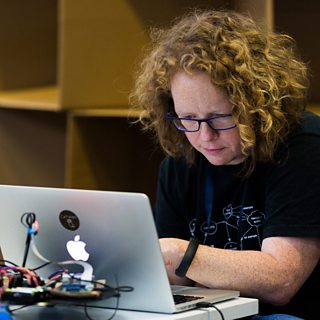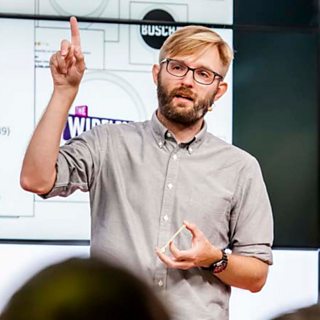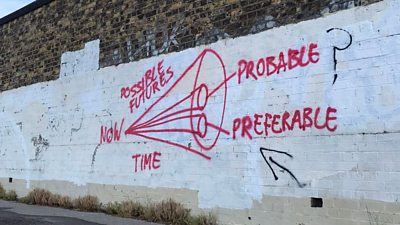
, taken in Leigh-on-Sea. Used with permission. Artist unknown.
R&D Futures is a project we've been working on in the background for a while; we’re interested in methods for spotting and extrapolating trends in our audience’s worlds, and how we in R&D and the ����tv can plan for those trends.
In this post, we’ll give some background to the project and outline its aims.
We think that this is the kind of thing that an R&D department should be doing, because it’s our job to think about what comes next: The Future, if you like. And, as a department, we already think about the future: you can have a pretty good idea of what comes next when you’ve had a hand in building it, or contributing to the spec, or it’s come out of your lab. As it frequently has with us, for broadcast and production technology.
What we could do more of, though, is anticipating how our audiences' habits or circumstances might change outside of the media technology sphere. If we’re going to design and direct our research towards the kinds of things people might want or need in three, five, or ten years time, then we should be spending time thinking about what those needs might be, and how their worlds might change.
As it happens, no-one’s particularly good at this because you’re into territory, and peering into crystal balls is a famously a mug’s game. But there are techniques and methods for imagining spreads of possible futures, and most of the people who do this kind of thing professionally call themselves futurists, and their practise futuring.
We’ve had a research interest for a long time in futuring methodologies; we’ve been particularly inspired by the work of our former colleague, , , ,, and. We’ve been starting to develop some tools and working practises for ourselves which we hope we can roll out around R&D and beyond as an exercise in capacity-building for all involved, training ourselves to think more regularly and broadly about what the future may hold for our particular areas of work.
Broadly, we’re aiming to develop three core areas of futuring practise:
- Build an ongoing signals gathering capability in R&D and elsewhere in the ����tv
- Devise a set of workshops for envisioning possible futures and outcomes of identified trends
- Run these workshops as a co-creation exercise with groups from under-served audiences
Let’s take a look at those aims in some more detail.
Aim 1: Building an ongoing signals gathering capability
Signals gathering is about collecting links to news stories, journal articles and other material which seems to point to a trend, or the first indications of something starting to happen or change. We drop links into Slack over the course of a month or so, and a bot collects them up for us. Many of you probably do this anyway in the course of your working day - we did too.
The difference is that now we look for things that are unusual or strange or might point to something bigger, rather than things that confirm what we already know and understand. The idea is that they may be things that point to a possible future, that might extrapolate out into bigger changes in the world, or evidence an underlying trend causing things to happen.
To examine this more closely, we get together on Zoom and Miro once a month and have a structured think together about these links. We group things with a common theme into one signal and ask: what's the signal? What's the change that's happening? Who is it changing for? What's the name of the trend?
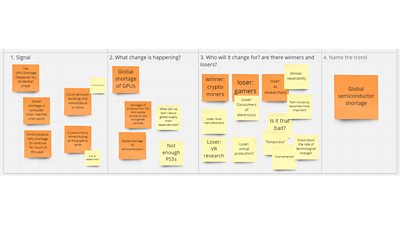
Here’s an example where we discussed the growing worldwide GPU and semiconductor shortage. We identified a few different signals indicating the same underlying trend, and evidence of some of its causes. We explored a few possible consequences of this and thought about which industries could be affected, and the effects on consumers.
We discussed how it might create bottlenecks for research and development of new technologies, but also how it might create opportunities for right-to-repair movements and component recyclers. Finally, we named the trend, fairly straightforwardly, “Global semiconductor shortage”
This work gives us some background knowledge of trends in the world. Not all of them will be directly relevant to the ����tv, but it gives us a signals spotting capacity, and increases our general sense of what might be happening now and over the horizon. The signals discussed in the monthly sessions might not always genererate directly actionable insights, but they do influence our thinking over time, and pop up in conversation while we work through ideas in our day-to-day work.
- A note for our ����tv colleagues: we welcome new members to this group, and we’d like to help other teams to develop this capability. Just drop us an email or find Libby Miller or Henry Cooke on Slack if you’re interested.
Aim 2: Devising a set of workshops to envision possible futures
We’re working on a set of three lightweight workshops, which start with signals gathering, work through their implications in more detail, and then develop scenarios or devise artefacts around those implications. Participants can take these outputs away to inform their own planning and strategy.
The workshops are designed to be remote-first, and are lightweight for a reason: we found that colleagues who have previously done long, chunky futuring or forecasting workshops found them cumbersome and dense, and so weren’t keen on doing them regularly. We think that doing these exercises regularly is vital to keep a team’s horizons open and their ideas about the future fresh, so we have purposefully honed our workshops down to a few key methods and kept them short.
The process results in a set of digital or physical artefacts, which could range from physical speculative prototypes or mocked-up photos and storyboards to written scenarios or user stories: whatever is most meaningful and useful to the particular group we are working with.
The workshop sequence
The first workshop is a one-off version of our monthly signals gathering session which we tweak and scope to work with specific teams on specific problems. At the end of this session, we have a set of signals and trends which a particular group think are interesting and relevant to their given area of work.
The second workshop centres around an , which we’ve found to be really useful and generative as a tool for thinking together about the snowballing knock-on effects of trends identified in the signals session. We ask: "if this comes to pass, what happens next?"
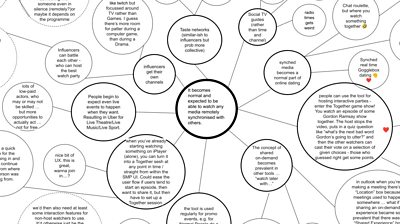
For example, in a world where it is normal and expected to be able to watch any media remotely synchronised with others…
- influencers get their own ‘channels’
- taste networks form collectively
- synched media becomes a normal part of online dating
- watching a show with its stars becomes a regular promo event
This lets us draw out some of the implications of a change, often in unexpected directions. It’s also an iterative process - once we have a set of possible outcomes from a trend, we ask ‘if this comes true, then what?’ again on those outcomes.
By the time we’ve worked our way through a couple of iterations of knock-on effects, a group starts to imagine a pretty wide spread of possible future consequences and expands their horizons in possibilities and timescales. At the end of this session, we have a collection of knock-on effects which represent small glimpses of possible futures.
The third workshop turns these glimpses into digital or physical objects, fleshing them out into tangible things that help people imagine possible futures more vividly. We like to use the term "" here - we’re interested in the sorts of things people will encounter in their everyday lives.
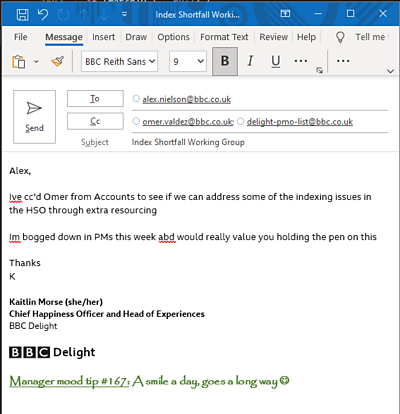
We love this email mockup by Galen made in response to the prompt: "What if employee happiness was an OKR for a business"?
Product or media reviews also work well. News headlines are a classic one. But anything that will draw out some of the implications of the change in a vivid or useful form comes into this category - hence our earlier mention of written scenarios and user stories. We want to leave teams with a set of anticipated possible futures, or trends, documented in a way that makes sense to them and will be useful in their everyday planning.
We’re hoping to provide all of these methods as services to anyone in the ����tv who wants them, as well as documenting the workshops and processes so that teams can pick them up and run them for themselves. It’s an exercise in capacity-building. We've started to work with some teams around R&D to pilot these workshops, and we're keen to work with others around the organisation who already do forecasting activities so we can learn from their methods and fold them back into our own work.
Aim 3: Co-creation with external groups
We’ve learned that the more diverse a group you can have working through these processes, the wider range of possibilities that group can envision. "Diverse" here is in any dimension - age, experience, gender, ethnicity, background, skills - all give you more information and more potential to bounce ideas off each other.
For instance, asking a group of senior managers about the consequences of synchronised media being commonplace will give you very different answers to those you’d get from a group of 18-year olds. This simple observation means that the more diverse groups we talk to, the wider a range of futures we can anticipate and the better equipped we will be to respond to whatever future actually happens.
So we plan to take these workshops out into the world and work with groups from under-served audiences to try to anticipate what pressures will be shaping their worlds over the next few years and how we, as a public digital media organisation, might be able to respond.
We’re sketching out plans to do this with students and primary age children.
What's next?
We’ll be posting updates as we work towards these aims, and we’re also hoping to post up bulletins from our monthly signals sessions as we go along. Finally, if you’re involved in futures or forecasting work at the ����tv or beyond and would like to discuss our and your work, please do get in touch!
View our monthly Signals Bulletins
- Signals Bulletin for June 2022
- Signals Bulletin for May 2022
- Signals Bulletin for April 2022
- Signals Bulletin for February 2022
- Trends summary for 2021
- Signals Bulletin for November 2021
- Signals Bulletin for October 2021
- Signals Bulletin for September 2021
- Signals Bulletin for July 2021
- Signals Bulletin for June 2021
- Signals Bulletin for May 2021
- Introducing: R&D Futures
